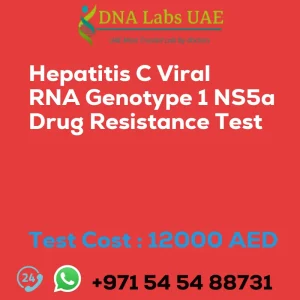PRENATAL DIAGNOSIS PANEL 1 CHORIONIC VILLUS BIOPSY Test
Test Name: PRENATAL DIAGNOSIS PANEL 1 CHORIONIC VILLUS BIOPSY Test
Components: This Panel tests the following diseases:
- Metachromatic Leucodystrophy (Code Y556)
- GM1 Gangliosidosis (Code Y557)
- GM2 Gangliosidosis (Code Y558)
- Gaucher Disease (Code Y559)
- Niemann Pick Disease (Code Y560)
- Fabry Disease (Code Y561)
- Pompe Disease (Code Y562)
- MPS-1 (Hurler) (Code Y563)
Price: 9360.0 AED
Sample Condition: Submit 20-30 mg (15 mg min.) Chorionic villus biopsy. Wash in minimal Essential media and put in Culture medium. Dissect immediately to remove decidua; Wash twice in cold 0.9% normal saline and add 0.2 mL of cold distilled water. Ship frozen within 24 hours. Sample should be taken at 10-13 weeks gestation. Duly filled Prenatal genetic testing consent form (Form 18) is mandatory. Sample to be dispatched with prior appointment.
Report Delivery: Sample Daily by 4pm; Report 5 days
Method: Enzyme Assay
Test type: Inborn errors of metabolism
Doctor: Pediatrician
Test Department: GENETIC
Pre Test Information: Sample should be taken at 10-13 weeks gestation. Duly filled Prenatal genetic testing consent form (Form 18) is mandatory. Sample to be dispatched with prior appointment.
Test Details
The Chorionic Villus Biopsy (CVB) test is a prenatal diagnostic test that is performed to detect genetic abnormalities in a developing fetus. The test involves taking a small sample of cells from the placenta, which is known as the chorionic villi, using a thin needle that is inserted through the mother’s abdomen or cervix. The sample is then analyzed in a laboratory to detect any chromosomal or genetic abnormalities.
The CVB test is typically performed between 10 and 13 weeks of pregnancy and can detect a wide range of genetic disorders, including Down syndrome, cystic fibrosis, sickle cell anemia, and Tay-Sachs disease. The test is highly accurate and can provide parents with valuable information about their baby’s health and potential medical needs.
However, the CVB test does carry some risks, including a small risk of miscarriage and the potential for inaccurate results. As with any medical procedure, parents should carefully consider the risks and benefits of the CVB test before deciding whether to undergo the procedure.
| Test Name | PRENATAL DIAGNOSIS PANEL 1 CHORIONIC VILLUS BIOPSY Test |
|---|---|
| Components | ThisPanelteststhefollowingdiseases: *MetachromaticLeucodystrophy(Code Y556) *GM1Gangliosidosis(Code Y557)*GM2Gangliosidosis(Code Y558)*GaucherDisease(Code Y559) *Niemann Pick Disease (Code Y560 )*Fabry Disease (Code Y561)*Pompe Disease (Code Y562) *MPS-1 (Hurler) (Code Y563) |
| Price | 9360.0 AED |
| Sample Condition | Submit 20-30 mg (15 mg min.) Chorionic villusbiopsy.WashinminimalEssential mediaandputinCulturemedium. Dissectimmediatelytoremovedecidua; Washtwiceincold0.9%normalsaline andadd0.2mLofcolddistilledwater. Shipfrozenwithin24hours.Sample shouldbetakenat10-13weeks gestation.Duly filled Prenatal genetic testing consent form (Form 18) is mandatory. Sample to be dispatched with prior appointment. |
| Report Delivery | SampleDailyby4pm;Report5days |
| Method | EnzymeAssay |
| Test type | Inborn errors of metabolism |
| Doctor | Pediatrician |
| Test Department: | GENETIC |
| Pre Test Information | Sample shouldbetakenat10-13weeks gestation.Duly filled Prenatal genetic testing consent form (Form 18) is mandatory. Sample to be dispatched with prior appointment. |
| Test Details |
The Chorionic Villus Biopsy (CVB) test is a prenatal diagnostic test that is performed to detect genetic abnormalities in a developing fetus. The test involves taking a small sample of cells from the placenta, which is known as the chorionic villi, using a thin needle that is inserted through the mother’s abdomen or cervix. The sample is then analyzed in a laboratory to detect any chromosomal or genetic abnormalities. The CVB test is typically performed between 10 and 13 weeks of pregnancy and can detect a wide range of genetic disorders, including Down syndrome, cystic fibrosis, sickle cell anemia, and Tay-Sachs disease. The test is highly accurate and can provide parents with valuable information about their baby’s health and potential medical needs. However, the CVB test does carry some risks, including a small risk of miscarriage and the potential for inaccurate results. As with any medical procedure, parents should carefully consider the risks and benefits of the CVB test before deciding whether to undergo the procedure. |








